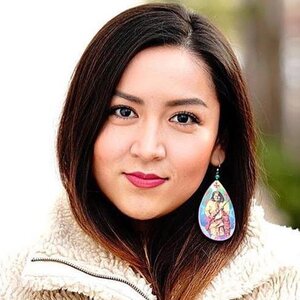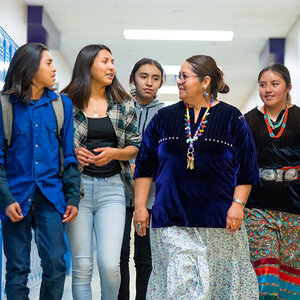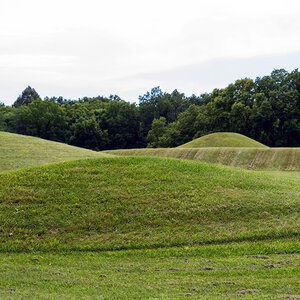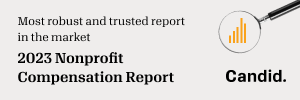Allie Young, Founder, Protect the Sacred
November 29, 2021
Allie Young is a citizen of the Diné Navajo Nation from the Northern Agency of the reservation in Northern New Mexico. She is founder of Protect the Sacred, which educates and empowers the next generation of Navajo and Indian Country leaders and allies to use storytelling and community building to strengthen Indigenous sovereignty and protect Indigenous elders, languages, and medicine ways. Protect the Sacred is a program of Harness, an organization launched after the 2016 presidential elections to educate, inspire, and activate an interdependent community of cultural organizers to use the power of storytelling to imagine and create a more equitable world.
Protect the Sacred began as an emergency response to the COVID-19 pandemic — which struck the Navajo Nation particularly hard — to organize Navajo youth to stay home and keep their families safe. Ahead of the 2020 elections, Young organized Ride to the Polls, which encouraged tribal citizens living on reservations and in remote communities to saddle up and travel to polling places. Over the past year, Protect the Sacred has expanded into a grassroots movement supporting frontline efforts to address the pandemic and ensure access to healthcare information and vaccines.
This Native American Heritage Month, PND asked Young about her work with Protect the Sacred, including efforts to contain the spread of COVID-19 and its impact on Native cultural heritage; her focus on youth; and the impact of storytelling on racial equity.
Philanthropy News Digest: What compelled you to return home to the reservation and launch Protect the Sacred? What were your immediate priorities in the earliest days?
Allie Young: In March 2020, I made the decision to travel from Los Angeles — where I’ve resided the last five years — to my homelands of the Navajo Nation to be with family and in my community. The first confirmed COVID-19 case reached the Navajo Nation before I did. By the end of March, the community was abuzz with talk of the rapidly rising positivity rate. By mid-May, the Navajo Nation dominated national headlines for having the highest per-capita infection rate in the United States. Few of these early articles spoke to the threat of cultural devastation posed by COVID-19. For my community and others like it, much more than death was at stake: All that we hold sacred hung in the balance.
When my former colleagues at the Indian Health Service asked in early March whether I’d be interested in helping them execute a social media campaign centered on COVID-19 awareness, I agreed without hesitation. This felt like a glimpse of hózhó (beauty and balance) — an opportunity to help change the trajectory of the virus in the Navajo Nation.
We set out to enlist young Diné people, through social media campaigns, in the fight against COVID-19. I created content encouraging Navajo youth to social distance, wear masks, and step up to leadership like our ancestors before us. One meme featured Annie Dodge Wauneka, a former Navajo public health hero remembered for her inspiring words, “I will go and do more.” I ended each post with #ProtectTheSacred, which would become the name of a new grassroots initiative.
Nine months later, Protect the Sacred — a program at Harness — continues to empower the next generation of Indian Country leaders and allies to protect our elders, our languages, our medicine ways, and our cultures.
PND: Protect the Sacred encouraged youth to take leadership in the community through the Navajo Youth Challenge, which called on them to relay information about the virus and help keep their families safe and informed — while reconnecting with their elders. And you organized Ride to the Polls to encourage tribal citizens to vote — to honor their ancestors, who rode for hours to vote, and to remind local officials that they will not be forgotten despite historical disinvestment. Why is it important for you to focus on youth leadership and storytelling in this context?
AY: It’s important to me to focus on youth leadership in our tribal communities because Native youth are the ones to carry on our traditional practices, languages, and cultures. The Indian Country Hero Challenge also encouraged young people to reframe staying home as an opportunity to learn language and culture, and facilitated community connections during an especially isolating time. These are cultural values that have been passed down to me and my siblings, and we’ve been taught that they are values that have protected our communities from genocide and forced assimilation — and have ensured our continual survival.
We believe Native youth are the future and that when their leadership is rooted in the culture they’re protecting, their foundation and resilience reflects that of their ancestors who fought for their existence. This kind of leadership, accompanied by powerful allies across the country, can mark a moment of transformation for Indian Country.
Storytelling is essential to any kind of organizing. A good story has the power to break down barriers, touch hearts, and change minds and behaviors. Community is often brought together by a shared story that resonates and empowers. When we can lean into the power of storytelling, especially storytelling that is grounded in culture in the face of some of the most challenging voter suppression laws and tactics, effective change is possible. It is about inspiring people to fight for and protect democracy for a more equitable society. Storytelling in the space of civic engagement creates opportunities for neighbors and allies from outside underrepresented communities to learn and understand the challenges, obstacles. The hope and goal is to inspire change and create solutions together.
PND: As a storyteller and writer, you’ve been focused on increasing the authentic representation of Native people in television, film, and mainstream media. Are you optimistic that the media and entertainment industry are undergoing meaningful, sustainable change?
AY: I am absolutely optimistic that the media and entertainment industry are undergoing meaningful, sustainable change, and in particular, when it comes to Indigenous stories told by Indigenous voices. I also believe that there is still a long way to go for Indigenous storytelling in the media and entertainment space; we’ve only just begun. For far too long, our stories have been excluded from the mainstream, and if there were stories told that “included” us, they were told by non-Native people, from a non-Native perspective — often through a “white savior” lens.
Within the last year, we’ve seen historic moments for Indigenous storytelling marked by investment in TV shows about Native communities by Native creators, producers, writers, directors, and crew. NBCUniversal launched the first Native TV comedy series, Rutherford Falls, on Peacock, and FX launched the first Native TV series with a mostly Native cast and crew, Reservation Dogs, on Hulu. Television has been around a very long time, and though it’s exciting to see progress for Indigenous storytelling, it’s also important to remember that it took this long for this type of meaningful change to happen. Only time will tell whether the change is sustainable, but one thing is for sure: Indian Country and I are both hopeful and working hard to ensure that it is. I’d also like to note that both of these historic and successful TV shows were launched on streaming platforms and Indian Country is still waiting for the moment that a Native TV show by Native creatives is on a primetime network.
PND: How can philanthropy better support grassroots efforts to protect Native communities, culture, and lands — and promote a more equitable world? Are there strategies that are being overlooked?
AY: Philanthropy can better support grassroots efforts to protect Native communities, culture, and lands by funding electoral and cultural organizing year round, as this kind of civic engagement and community organizing never really stops in our communities. These groups help to create the conditions to win on climate, environmental, gender, and civic justice across Native America. It’s also important to invite these groups to the table for the opportunity to share their stories, and then to sincerely listen to their stories.
Much of our work in Indian Country is rooted in storytelling and culture, and that is the work that truly moves the needle on our priority issues. I’ve also been an advocate for building deeper relationships with Native communities by taking the time to visit our communities and sitting down with tribal, community, and nonprofit leaders. Supporting Native communities is also about building trust with our people, and when national leaders, funders, and allies come out to our reservations and communities, it takes the support and work to another level for positive and sustainable change.
PND: There has been much talk about the need to center Indigenous voices and perspectives in efforts to mitigate the impacts of climate change. What role, if any, do you see for effective storytelling in that effort?
AY: It is of utmost importance to center Indigenous voices and perspectives around climate change and solutions, especially Indigenous storytelling. Many of our creation or origin stories, as well as traditional practices passed down from many generations before colonization, center values and lessons about our relationship with Mother Earth and how to be good stewards of the lands and waters.
As we find ourselves at this necessary intersection of storytelling and environmental and climate justice, we must remind ourselves that Native American communities have immense knowledge in both arenas and have been weaving the two in the form of creation stories since time immemorial. It is no coincidence that 80 percent of the world’s remaining biodiversity is kept safe in Indigenous territories and communities, considering our stories of Mother Earth that teach us about the importance of our stewardship of the land — that her survival is dependent on our relationship to her and our animal relatives.
I strongly encourage philanthropy, Hollywood, and other investors to consult with Indigenous peoples in this fight to save the earth and humanity. We are the original storytellers and we are the original activists. We’ve been in this fight for a very long time — more than five hundred and twenty years – and we’ve survived it; we know what we’re dealing with and what we’re up against.
—Kyoko Uchida






